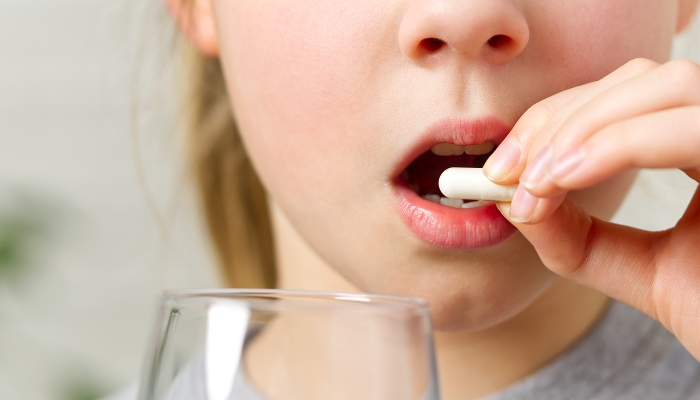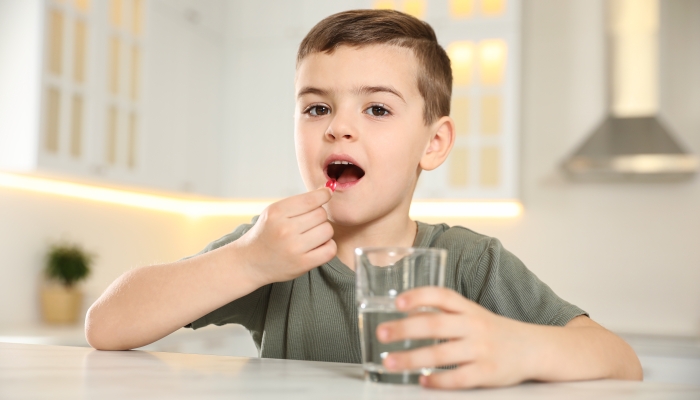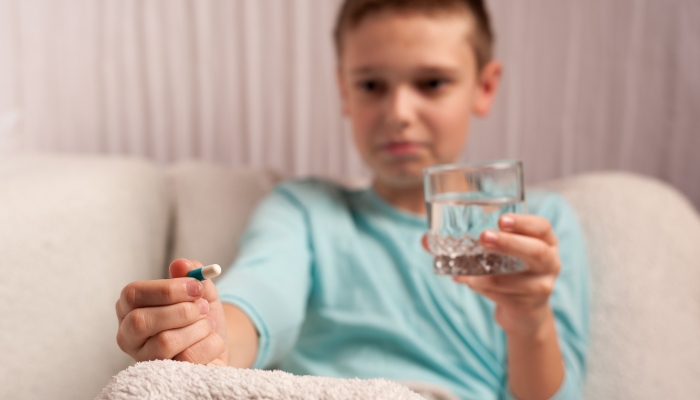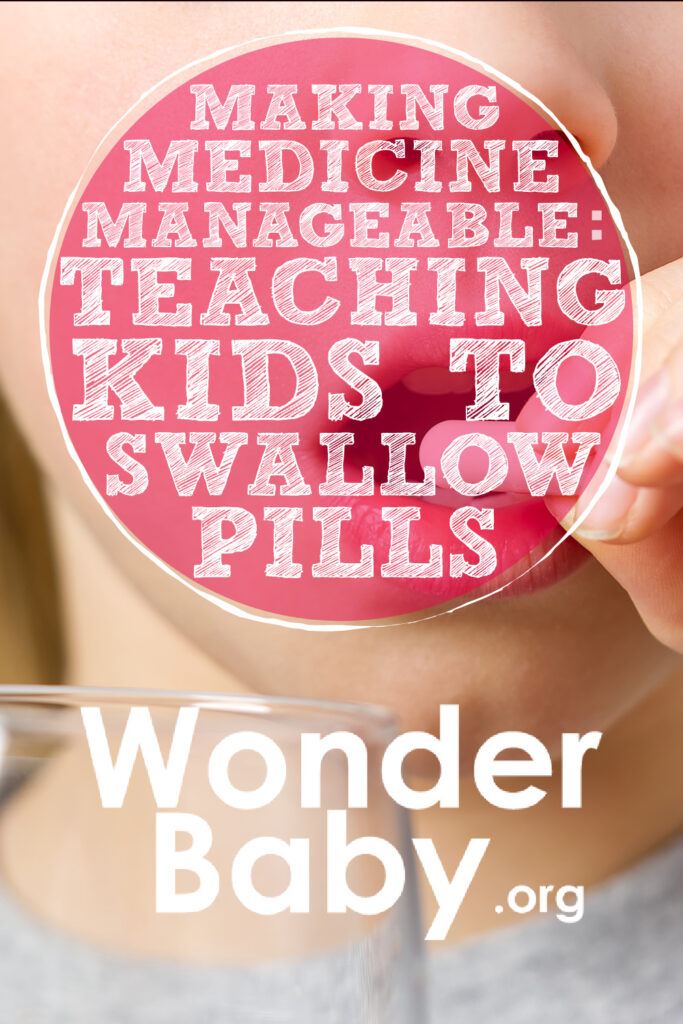Making Medicine Manageable: Teaching Kids To Swallow Pills

This post may contain affiliate links; please see our terms of use for details.
- Most kids age four and up can learn how to swallow a pill.
- A positive learning environment helps a child learn this and other skills.
- Parents can help their children be successful in swallowing pills by using candy or a favorite drink as they learn.
- Medication safety is also important to teach your child.
I have vivid memories of the first time my child tried taking medicine by mouth. Since my child could easily swallow vitamin drops—and because I’m a nurse—I assumed this would be a simple process with minimal fuss.
It turns out that even teaching a child how to swallow liquid medications can be quite the process. That pink goo ended up everywhere except their mouth, leaving both of us a sticky, worn-out mess.
Like other developmental tasks, it takes practice to learn the important skill of pill swallowing.
Helpful techniques are available that can help your child learn this skill and make it a positive experience for you and them.
Why Should Kids Learn to Swallow Pills?

Teaching a child to swallow pills is a necessary skill.
As they grow, many medications will only be available in pill form or may be more effective in pill form.
There’s also a financial aspect to consider. A 2018 study11. Hori, K. S., Siu, A. M., & Yamamoto, L. G.. Replacing Liquid Antibiotics With Cheaper Pill Equivalents: An Opportunity for Substantial Savings. Clinical Pediatrics. 2018;57(11), 1294–1299. https://doi.org/10.1177/0009922818774340 that examined the cost of giving antibiotics in pill form instead of liquid found that, over two years, an estimated $1 million could have been saved—simply by giving the medication as a pill. Teaching your child to swallow pills could save you money at the pharmacy.
Preparing to Teach Your Child

How can you tell when is the right time or know the right ways to teach your child how to take medication?
After all, isn’t learning to swallow pills just a matter of taking a big gulp of water, tossing in the pill, and swallowing?
As with learning other skills, a little advanced preparation can go a long way in setting your child up for success.
The Right Age to Start
Consider that most children are not developmentally ready to learn this skill until at least 4 years old because of their oral motor capabilities.
Many kids have trouble coordinating swallowing movements when they know there’s something on their tongue and gag, sputter, and spit in response.
Wait to teach swallowing pills until your child has consistently shown the ability to successfully swallow—and retain—food and liquid of different textures and thicknesses.
Creating a Positive Environment
Parents and children alike may have some fears about learning to swallow pills and medications.
Creating a positive practicing environment allows your child to feel safe trying out their abilities to learn a new developmental skill.
To best position your child for success in learning to swallow a pill, try these tips:
- Remove distractions and turning off TVs or devices.
- Provide a calm, comfortable, and positive setting.
- Choose a time of day when your child is likely to succeed. For example, if they always fall apart in the middle of the afternoon, there may be a better time of day to work on a new skill.
- Practice before you need the skill. Said differently, learning how to swallow a pill when your child is sick, needs medication, has a sore throat, or has the pressure of immediate success is not the best time for teaching.
- If your child has worries or other strong feelings, talk about them with your child before the training session. Validate their feelings and concerns, while providing encouragement.
- Make sure your child feels relaxed while practicing. Avoid unnecessary tension or making them feel rushed or stressed.
- Try to keep your responses calm and positive, even if things don’t go as planned.
- Be patient. Learning a new skill of any sort takes time and practice.
- Praise their efforts. Even (and especially) if unsuccessful at first.
Remember that learning to swallow a pill won’t happen overnight. Try to practice for about five to ten minutes a day, most days, for about two weeks.
Step-by-Step Guide to Teaching Kids to Swallow Pills

Ready to learn? This step-by-step guide will help you to successfully teach your child how to swallow pills.
Step 1: The Pill-Swallowing Process
Pediatric psychologist Dr. Jennifer Butcher22. Younghans, J.. How to help kids swallow pills in 7 easy steps. Michigan Medicine. 2022. https://www.michiganmedicine.org/health-lab/how-help-kids-swallow-pills-7-easy-steps from the University of Michigan encourages parents to seat their child, encourage them to sit straight, and then drink a little water to get their mouth wet.
Next, place (or have your child place) a very small piece of candy, like a single sprinkle, on your child’s tongue and take a few sips of water from a cup or drink with a straw to wash it down.
End each session on a positive note with a hug or kiss and a small reward, like a sticker.
Step 2: Practice with Small Pieces of Candy
Katie Grabowski33. Teaching Your Child How to Swallow a Pill. The Johns Hopkins University. https://www.hopkinsmedicine.org/health/wellness-and-prevention/teaching-your-child-how-to-swallow-a-pill, a child life specialist at Johns Hopkins All Children’s Hospital, suggests purchasing candy in a variety of sizes and shapes to represent various pills that children may take at different points in their lives.
Think of a range of candies, such as tiny ice cream or cake sprinkles, nonpareils, Tic-Tacs, M&Ms, Skittles, mini or regular-size chocolate chips, or Mike and Ikes.
Start with a small item like a cake sprinkle or Tic-Tac to allow your child to practice swallowing an unfamiliar object and build your child’s confidence through repeated practice.
Step 3: Progress to Larger Sizes
Once your child has shown consistent success in swallowing small pieces, gradually increase the size and use all or part of larger candies until you’ve reached the size of the medication or pill they will likely take.
This part of the learning process involves lots of patience from kids and parents. Your child may start to show behavioral problems, like tantrums, and you may be tempted to give up.
Rather than push through a given training session, childhood experts suggest swallowing your pride and ending early that day if your child refuses to cooperate. Mental blocks about swallowing pills form more easily when a child is forced into an experience they aren’t prepared to handle.
Step 4: Introducing the Pill
Once your child has shown repeated success in swallowing candy in a variety of sizes, it’s time to transition them to an actual pill.
For some children, they will need to swallow pills daily as part of managing a health condition. Others will use the skill on an as-needed basis.
Over-the-counter (OTC) and prescription medications are usually bitter, which is done purposefully44. Mennella, J. A., Spector, A. C., Reed, D. R., & Coldwell, S. E.. The Bad Taste of Medicines: Overview of Basic Research on Bitter Taste. Clinical Therapeutics. 2013;35(8), 1225–1246. https://doi.org/10.1016/j.clinthera.2013.06.007 to discourage accidental ingestion or overdose.
Consider using a few sips of juice or another special drink, like chocolate milk, to help manage the bitter taste and aid in pill swallowing.
Medication Safety

As with most safety-related issues, there are practices to promote and avoid when discussing safe medication use.
When teaching your child to swallow medicine, do:
- Keep the process as relaxed and natural as possible. If your child senses that you’re anxious, they’re more likely to be anxious and worked up too.
- Give praise without overdoing it.
- Keep all training candies or items, including actual medications, secured in child-proof containers and out of reach. The last thing you need is accidental ingestion or choking on unintended items.
At the same time, try to avoid:
- Referring to pills or medications as treats, goodies, or “gummies.” Curious small minds (and hands) don’t know the difference between fruit snacks, gummy bears, and chewy medications like children’s vitamins. Clearly label bottles containing medication to prevent accidental ingestion or overdose, both of which are dangerous for children of all ages.
- Forcing the process. Like other developmental tasks, such as potty training, kids learn this skill when they’re ready—which may or may not be on your expected timeline.
- Leaving your child alone or unattended when learning to swallow pills. Accidental choking is always a concern for young children, and adults should be within arms reach at all times.
Like putting on clothes or learning to tie shoes, teaching your child to swallow a pill is an important developmental skill. Being patient with your child as they master this task encourages them to build self-confidence and believe in their ability to succeed in future learning situations.
References
- Hori, K. S., Siu, A. M., & Yamamoto, L. G. (2018). Replacing Liquid Antibiotics With Cheaper Pill Equivalents: An Opportunity for Substantial Savings. Clinical Pediatrics, 57(11), 1294–1299. https://doi.org/10.1177/0009922818774340
- Younghans, J. (2022, March 24). How to help kids swallow pills in 7 easy steps. Michigan Medicine. https://www.michiganmedicine.org/health-lab/how-help-kids-swallow-pills-7-easy-steps
- Teaching Your Child How to Swallow a Pill. The Johns Hopkins University. (n.d.). https://www.hopkinsmedicine.org/health/wellness-and-prevention/teaching-your-child-how-to-swallow-a-pill
- Mennella, J. A., Spector, A. C., Reed, D. R., & Coldwell, S. E. (2013). The Bad Taste of Medicines: Overview of Basic Research on Bitter Taste. Clinical Therapeutics, 35(8), 1225–1246. https://doi.org/10.1016/j.clinthera.2013.06.007

The information WonderBaby provides is not intended to be, and does not constitute, medical or other health advice or diagnosis and should not be used as such. Always consult with a qualified medical professional about your specific circumstances.
Related Posts

Eye Conditions and Syndromes, Visual Impairment
Neuralink Announces Plans to Restore Sight to the Blind with Brain Chip
Elon Musk’s company Neuralink has announced plans to begin human trials of its new “Blindsight” brain chip by the end of 2025.

Health & Nutrition
Can Baby Skin Care Products Expire?
Is that forgotten tube of diaper rash cream still safe to use? Learn more about the expiration dates of popular skin care products for infants.

Health & Nutrition
Boosting Immunity in Kids: 3 Tips for a Healthy Winter
Parents can help boost their kids’ immunity during cold and flu season by maintaining healthy eating, sleeping, and exercising habits in the winter.